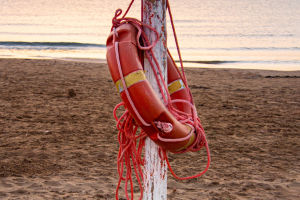Lifebuoys, crucial equipment for water rescue, are frequently deployed to save the lives of individuals who have fallen into the water.
However, for many, a life preserver might be a mundane object lacking a profound understanding of its principles and proper usage.
This article aims to delve into the intricacies of the lifebuoy, elucidating its design, function, and usage techniques to foster a comprehensive comprehension of this life-saving tool.
1. Design and Structure of the Lifebuoy
A lifebuoy typically comprises a round buoyant float and a rope. Floats are commonly crafted from foam plastic or inflatable materials, chosen for their lightweight and durable properties.
The rope is typically affixed to the float's center, facilitating the rescuer in deploying the lifebuoy into the water and towing the individual in distress to safety.
Lifebuoys are typically sized larger to ensure they possess adequate buoyancy to support the weight of an adult. Their exteriors are often adorned with bright colors to enhance visibility in the water, thereby improving rescue efficacy.
2. The Functions of the Lifebuoy
a. Provide Buoyancy: The primary function of the lifebuoy is to furnish Buoyancy, enabling the individual submerged in water to keep their head above water, thereby preventing drowning.
b. Serve as Auxiliary Equipment: Lifebuoys can be thrown to distressed individuals, providing them with a stable buoyancy point while awaiting rescue.
c. Act as Towing Equipment: The rope attached to the lifebuoy allows rescuers to tow the distressed individual to a safer location or shore.
d. Serve as a Visible Signal: The conspicuous color and distinct shape of the lifebuoy facilitate easy detection in water, serving as a distress signal to guide rescuers to the location of the individual in distress.
3. Tips for Correctly Using Lifebuoys
a. Familiarize Yourself with the Lifebuoy's Location: In areas prone to water-related accidents, ensure lifebuoys are stored in easily accessible locations and rescuers are acquainted with their whereabouts.
b. Tips for Throwing a Lifebuoy: When deploying a lifebuoy, ensure the rope is fully extended, avoiding knots or entanglements that could impede the accuracy and distance of the throw.
c. Posture When Using the Lifebuoy: Individuals in distress should position the lifebuoy beneath their chest, with their arms resting on the float to maintain stability and comfort.
d. Please pay Attention to the Individual's Status: When towing with a lifebuoy, rescuers should closely monitor the individual's distress condition, ensuring their safety and providing additional support.
4. Conclusion
Lifebuoys, vital water rescue equipment, are indispensable in saving the lives of distressed individuals.
Through a profound understanding of their design principles, functions, and correct usage techniques, we can effectively respond to water emergencies, enhance rescue efficiency, and safeguard lives. Therefore, everyone must bolster their comprehension and proficiency in handling lifebuoys.


